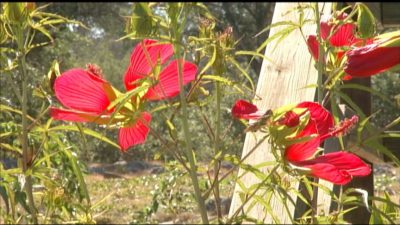Texas Star Hibiscus
Hibiscus coccineus

This wonderful naturalized Texas perennial is also known as scarlet rose mallow. Although related to the tropical hibiscus that are found in Hawaii and other warm, wet regions, Texas Star hibiscus is quite happy in temperate Central Texas. It grows 3 to 6 feet tall and about 4 feet wide and dies back to the ground in winter. As with other perennial shrubby plants, wait until temperatures begin to warm up in spring and then prune off all of the top growth down to the ground and you’ll begin to see the new growth emerge from the roots. Resist the urge to prune off all the stems in late fall or early winter as soon as all the leaves have dropped off. As the plant is preparing to hunker down for winter, many chemical processes are occurring in those “dead” stems. And, the leafless stems provide a little bit of protection from the cold.
Unlike its tropical cousins, Texas Star hibiscus can withstand most of our winters, barring any truly harsh freezes. Be sure to mulch well around the base of the plant to protect the roots from any out of the ordinary cold spells. It can take full sun, but also does fine in part shade, although it may bloom a little less. Texas star Hibiscus can handle wet soils, but works in dry ones, too. Although it will acclimate to our soils and need very little supplemental irrigation in “normal” times, if summer is particularly hot and dry, you will need to water this plant. It spends the spring putting on green growth and then flowers all summer long, attracting a parade of hummingbirds and butterflies to your garden. The flowers are large, off-red, and more open than the showy tropical hibiscus, with 5 very distinct petals. Each flower is only open for a day, but new ones open all summer long. Gardener Randy Case says that Texas Star hibiscus have made it through extreme drought and cold in his water-conserving garden. Gail at Natural Bridge Caverns reports that she does not baby them at all. They’re the first plants up in the spring and the first ones to recede in the fall. She doesn’t usually have insect problems on them, either, except a little pill bug damage, and grasshoppers, if it’s a bad year for them. Gail also reports that she allows the seed pods to dry and then breaks them and scatters the seeds around where she wants more plants next year, and also, easily propagates the plant by cuttings. And lastly, Gail points out that she has had the occasional visit from the sheriff’s deputy, as the leaves of Texas Star hibiscus do look strikingly similar to the leaves of a completely different, illegal plant.
categories:
